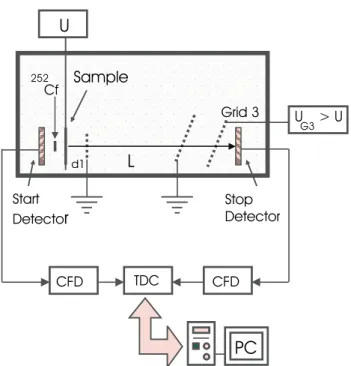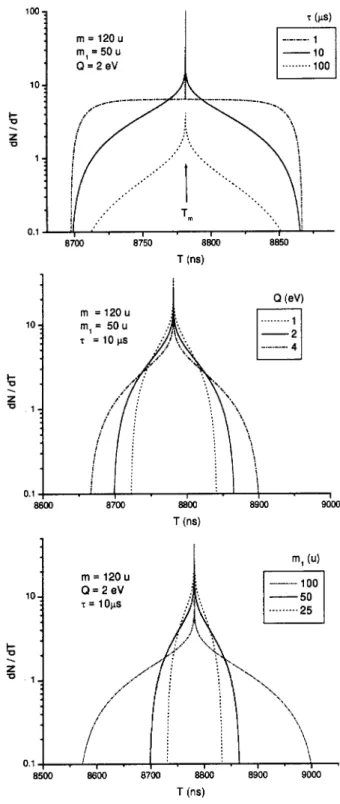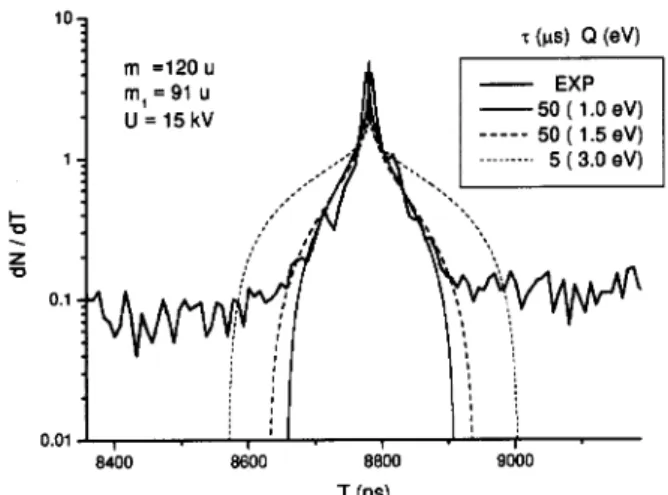Dissoiation of Fast Ions Analyzed by Time-of-Flight
C.R. Poniano, R.C.C. Ladeia,V.M. Collado,and E.F.da Silveira
Departamento deFsia,PontifiaUniversidadeCatoliadoRiodeJaneiro,
RuaMarqu^esdeS~aoViente, 225,CP38071, Rio deJaneiro22452-970,Brazil
Reeivedon9May,2001
The fragmentation ofmetastable ions,havingkeVofkineti energy, is analyzedbytime-of-ight
tehnique. Assumingisotropidistributionoffragmentsinafreeeldregion,itisdeduedan
analyt-ialexpressiontodesribetheorrespondingpeakshapesinlinearTOFspetrometers. Metastable
ionmean-lifeandthekinetienergyrelease(Q-value)arethequantitiesextratedfromdatatting.
Asanillustration,thedissoiationofC8H10N +
metastableions,desorbedby 252
Cfssionfragment
impatonorganitarget,isstudied.
I Introdution
Moleular dissoiation has been investigated over
deadesbyphysiistsandbyhemistsforreasons
rang-ingfromfundamentalstudiestopratialappliations.
Suh studies are important gateways for the
under-standing of moleular struture from an interatomi
foredesription.
There are several possible agentsto indue
mole-ulardissoiation,suh aslaser,synhrotronlight,
ele-tronandionbeams,aswellasmanyexperimental
teh-niquestoanalyzetheproduedfragments. These
teh-niquesaredesignedaordingtothespei
harater-istis of the projetile-target system: gaseous or solid
target,absoluterosssetionofthephenomenon,
sele-tivityoftheexitation,moleularstrutureomplexity,
et. Literatureonthissubjetisimmense,sothatthe
followingdisussionwillberestritedtometastableion
speiesdissoiation;somebasireferenesare1-10.
Inthisartile,itisonsideredthesituationinwhih
a fast single-harged metastable preursor dissoiates
into two stable fragments: one neutral and another
single-harged ion. Inontrast to ions produed
usu-allyinlaboratorywithafeweVofkinetienergy,fast
ionsarethosemovingin thekeV-energyrange. Under
this aspet, metastableions maybe dened as
unsta-ble speies that live longenough to beome fast ions,
surviving external high eletri eld aeleration and
having their deay diretlyobserved. Byusing a
typ-ialkV/mm aelerationeletrield, this means- in
pratie- that metastableions have mean-lives larger
than100ns. Amethod,basedontime-of-ight(TOF)
tehniqueisdevelopedtoestimate,theionmean-life,
andtodetermineQ,thekinetienergyinreasedueto
fragmentation. Theanalysisisthenappliedforthe
dis-soiationofdesorbedionsfromsolidtargetsbombarded
byMeVprojetiles.
II PDMS and the experimental
set-up
Themassdeterminationofthedesorbedionswasdone
byahome-madelinearPDMSspetrometer,Fig. 1. A
verybriefdesriptionofPlasmaDesorptionMass
Spe-trometry[11℄follows. A 252
Cfssionfragmentsoureof
about20Ciisusedtoinduedmetastableion
desorp-tionfromsolidsamples: whileonessionfragment
im-patsthetarget,detetionoftheomplementaryssion
fragmentgeneratesastart signalforthe TOF
aquisi-tion system. The desorbed ionsare aeleratedin an
uniform eletrield region (length d
1
) and launhed
towardsamuhlongereletrieldfreeregion(length
L). Ifionfragmentationdoesnotourinnoneofboth
regions, theionsaredetetedin thestopdetetorand
theirtimesofight,T
m
,aremeasured.
DeningU astheextrationpotentialandqas the
ion harge,and onsidering thatthe initialkineti
en-ergy (eV) of the desorbed ions are negligible with
re-spet to their nal energy (E
f
= qU 10 keV), the
massofeahionspeiesisgivenby
m= 2E
f
v 2
=2qU
T
m
2d
1 +L
2
(1)
Anionlterlosetothestopdetetormaybe
ati-vatedonlywhendetetionofneutralfragmentsare
de-sired. Inthis ase,thegrid3potential(U
G3
) mustbe
greaterthanthesamplepotential(U)andEq. 1holds
only for neutrals. Detailed desription of this PDMS
spetrometeranbefoundin referene[12℄.
Figure 1. Diagramof a 252
Cf- PDMStime-of-ight mass
spetrometer. U isthetargetpotentialandUG3 istheion
lterrepellingpotential. d1 =0.70mandL=134mare
the aelerationandfreeeldregionlengths. Thetime
in-tervalbetweenthestartandthestopsignalsismeasuredby
theTDCunit. Theeletronideviesare: CFD-Constant
FrationDisriminator;TDC-TimeDigitalConverter;PC
-PersonalComputer.
III The fragmentation analysis
Aordingtothepreviousdenition,themetastableion
speies meanlife, , is omparableorlonger than the
traversingtimeovertheaelerationregion
t 1 =d 1 r 2m qU (2)
Moreover,if itis shorterthanitstotaltime ofight
T
m
, a substantial fration of the desorbed metastable
ions disintegratesin the eld free region. The binary
proessm + !m 0 +m + 1
isthemostlikelytoourand
the kinetienergyexess, Q,appearsafter
fragmenta-tion: Q= 1 2 m 0 v 2 0 + 1 2 m 1 v 2 1 1 2 mv 2 (3)
where, in thelaboratoryframe, v
0 and v
1
are the
ve-loities ofthe neutraland harged fragmentsand v is
the preursor metastable ion veloity in the free eld
region.
Inthepreursorionframe,thediretionofthe
frag-mentationaxisisdistributedisotropiallyandthe
frag-ment veloities v arepromptly determined by linear
momentum onservation: v 0 = r 2m 1 mm 0 Q (4a) v 1 = r 2m 0 mm 1 Q (4b)
If fragmentation ours at the instant t
f
after
des-orption, the distane preursor ion to the detetor is
L v(t
f t
1
):Therefore,thearrivaltimesoftheneutral
andhargedfragmentsatthedetetorarerespetively
T 0 =t f + L v(t f t 1 )
v+v
0 os (5a) T 1 =t f + L v(t f t 1 )
v+v
1
os(+)
(5b)
where is theangle betweentheneutralfragment
ve-loity,inthepreursorionframe,andthespetrometer
axis.
Integrationovergeneratesthetime-of-ight
distri-butionn(T)=dN=dT forthefragments,whih shape
dependsdiretlyonQ: largerisQ,broaderistheTOF
peak. This integral should be performed very
are-fully for two reasons: i) the instant t
f
is not xed,
butbelongstoanexponentialdeay-typeprobabilisti
distribution;ii)in thepreursorframe, thedetetor is
movingtowardsthefragments. Thisfat brings
math-ematial diÆulties, whih are partially solved if one
onsidersthatvv:
For an ensemble of fragmentation eventsourring
betweent f andt f +dt f
,theneutralandionfragments
willbedispersedisotropiallyintwoexpanding
spheri-alshellsenteredin thepreursorenterofmass. For
eahshell,thenumberoffragmentsemittedinthesolid
angledis
d dN dt f = d 4 n f (t f ) (6) where n f (t f )= N 0 e tf= (7)
is the fragmentation rate at instant t
f
. Our goal is
toalulatethenumberofpartiles,foreah fragment
speies, dN, arrivingbetweenT andT +dT:The
dis-tributiondN=dT isthequantitytobeomparedtothe
experimentalpeakshape,whihisdiretlyprovidedby
the aquisition system. During the time interval dT,
thefragmentsof eah shell, produed betweent
f and t f +dt f
,reahthedetetorinsidearingorresponding
tod=2sendandin arate
d 2 N dTdt f = 1 4 n f (t f )2send (8)
Thisexpression needsto beintegrated overt
f
, within
limitsompatiblewithfragmentdetetionatinstantT,
and at max
f
must be determined for eah arrival time.
Forexample,itisnotpossiblethatthefragmentarrival
timesbeverydierentfromT
m
iffragmentationours
lose to the detetor. Imposing = 0 in Eq. 5, one
Inthis expression, oneshoulduse v=v
0
orv =
v
1
respetivelyfortheneutralorionspeies. The
in-tegration of Eq. 8 beomes, after somemathematial
manipulationusing Eqs. 5and7:
dN
dT =
v
2v N
0
Z
t max
f
t
1 e
t
f =
T
m t
f
(T t
f )
2 dt
f
(10)
foreah fragmentspeies.
If t max
f
, the expression 10 an be integrated
analytially,givenapeakshapewhihhasa
logarithm-typedivergene atT =T
m
. If t
1
, thepeakshape
is loseto a 1=(T t
1 )
2
distribution, keepingthe
sin-gularityatT =T
m :
It anbeseenfromthese expressionsthatthe
neu-tral and ion fragmentpeaks appear at the same
posi-tionasthenon-fragmentedpreursorpeak,sothat
ex-perimentallyoneobservestheoverlappingofthethree
peaks. Tosimplify theexperimental analysis,onemay
introdueanion lterjust before thedetetor and let
only neutralfragmentsto be deteted. It is also
pos-sibleto deetedtheyingionsintoaseonddetetor
andseparatethepreursorionpeak fromtheion
frag-mentone. Eqs. 4,9and10alsoshowthatthefragment
peakshapesdependontheionfragmentandpreursor
massratio. Therefore,ifm
1
is notknown,it mayalso
usedasfreeparameterinthepeakshapeanalysis.
IV Results and disussion
In order to understand theeets of , Q and m
1 =m
ontheEq. 10 theoretialpreditions,simulations
or-respondingtopossiblerealongurationsarepresented
in Fig. 2 form = 120u;qU =15 keV, d
1
= 0:70m
andL=134m. Theobtainedneutralfragmentpeak
shape are respetively shown in Figs. 2a, 2b and 2.
Generalommentsare:
i)TheurvesarefairlysymmetriaroundT =T
m .
FragmentationeventswithT <T
m
orrespondto
neu-tral emission towards the detetor (neutral fragments
are faster than their preursor), while T > T
m ones
refertoionfragmentemissioninthisdiretion.
ii)Therearetwobasiontributions: one,produed
bydissoiation farfrom thedetetor andgenerating a
verybroaddistribution; the other oneis produed by
dissoiationslosetothedetetorandgeneratinga
pro-nounedpeak.
iii)Longer is, lessdissoiationsourin theeld
free region and less lear is the border between the
broadandthepeakontributions(Fig. 2a).
iv)LargeristheQ-valueortheionfragmentmass,
broader the dN=dT distribution is, and lower is the
bakgroundlevel(Figs. 2b and2). Infat,note that
inEq. 4a,v inreaseswiththeprodutm Q.
Figure 2. Simulations based on Eq. 10, showing
respe-tively ina,band,the,Qandm
1
parametereets on
theTOFpeakshapeof neutralfragments. Theonsidered
preursoriondissoiationis120 +
!m +
1 +m
0
:The
extra-tionpotentialis15kVandthespetrometerlengthsared1
=0.70mandL=134m. AsingularityoursatTm =
8781ns,thenon-fragmentedpreursorTOF.
Preditions are now ompared with experimental
data obtainedfrom thessionfragmentbombardment
onphenylalaninetarget(moleularmass M =165u).
An ion lter was employed, so that only the neutral
al-lowed to be deteted in the linear spetrometer. The
obtainedneutralfragmentTOF spetrumis presented
in Fig. 3, in whih themost prominentpeakrefersto
mass 120 u preursor (C
8 H
10 N
+
). It has been
sug-gest [12℄, from TOF-oinidene measurements, that
thetropyliumion(m
1
=91u,C
7 H
+
7
)formationisthe
pathway for the 120 +
fragmentation. Assuming suh
fragmentation,Q=1.0eVand 50swerethebest
parameter values in the data tting with Eq. 10, as
illustrated in Fig. 4. It should be mentionedthat no
modiationin thet max
f
expression(Eq. 9) was
intro-dued dueto theativatedion lter,whihsuppresses
fragmentationintheregionbetweenitandthedetetor.
Figure3. NeutralfragmentTOFspetrumofthedesorbed
positiveionsfromaphenylalaninesample. U =15kVand
UG3=17.6 kV.The120uisthemassofthesingle-harge
preursorion whihdissoiationisbeinginvestigated. The
spetrometermass resolutionan beappreiated fromthe
m=188umasspeakwidth.
V Conlusions
The dynamis of binary fragmentation of a free
metastableioninTOFlinearspetrometerisdesribed
by analytial expressions and peak shapes of neutral
and ion fragment peaks are predited. The method
wasappliedto theneutralfragmentpeakshapetting
of the C
8 H
10 N
+
metastable ion deay, assuming the
120 +
! 91 +
+29 Æ
pathway. A good agreement with
our experimental data was found for Q= 1.5 eVand
50sparameters,givingondenethat themodel
isabletodesribethephenomenon.
Aknowledgements
CNPq, Faperj and PADCT III are gratefully
a-knowledged by their partial support to this work.
Figure4. Comparisonofthe120peakshape,seletedfrom
theneutralfragmentTOFspetrumofFig. 3,withEq. 10
theoretialpreditions. Resultsfromthreesetofparameter
valuesareshown.
Referenes
[1℄ R.G. Cooks, J.H. Beynon, R. M. Caprioli and G. R.
Lester, Metastable Ions, Elsevier Sienti Publishing
Company,1973.
[2℄ W.F.HaddonandF.W.MLaerty,AnalytialChem.
41,31(1969).
[3℄ F.W.MLaerty,Interpretation of Mass Spetra,
Uni-versitySieneBooks,3rdEdition, 1980.
[4℄ B.T. Chait, Int. J. Mass Spetrom. IonPhys.53, 227
(1983).
[5℄ S.Della-NegraandY.LeBeye,Anal.Chem.57,2035
(1985).
[6℄ A.Shueler,R.Beavis,G.Bolbah,W.Ens,D.E.Main
and K.G. Standing, Springer Ser.Chem. Phys. 44, 57
(1986).
[7℄ X.Tang,R.Beavis, W.Ens,F.Lafortune,B. Shueler
and K.G. Standing, Int. J. Mass Spetrom. Ion
Pro-esses,85,43(1988).
[8℄ H.J.Neusser,Int.J.MassSpetrom.IonProesses,79,
141(1987).
[9℄ P.A. Demirev, Mass Spetrometry Reviews, 14, 279
(1995).
[10℄ R.J. Cotter, Time-of-Flight Mass Spetrometry -
In-strumentation andAppliations in BiologialResearh,
ACSProfessionalRefereneBooks,1997.
[11℄ R.D. Mafarlane and D.F. Torgerson, Int. J. Mass
Spetrom.IonPhys.21,81(1976).
[12℄ C.R.Poniano, Dotoral Dissertation,Pontifia


